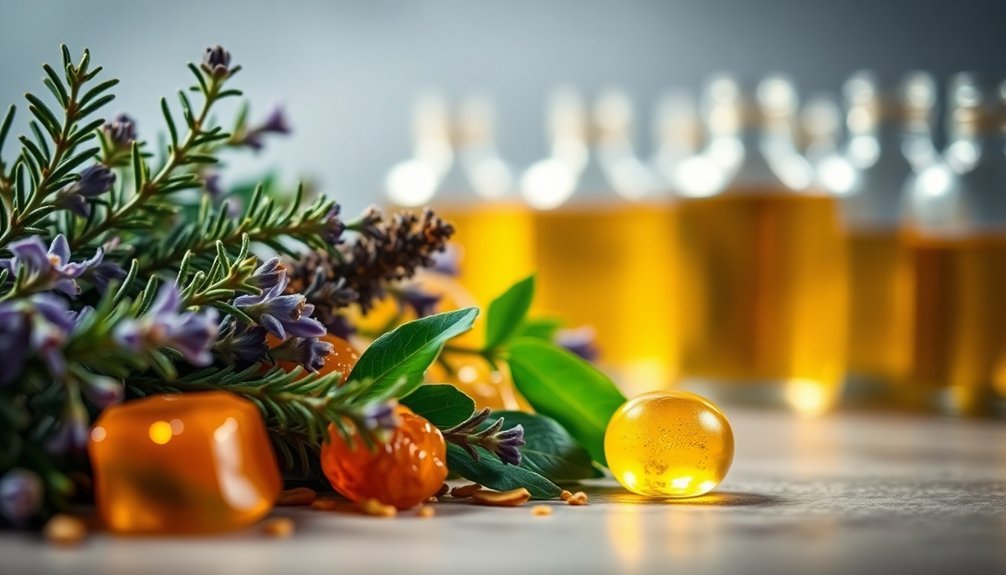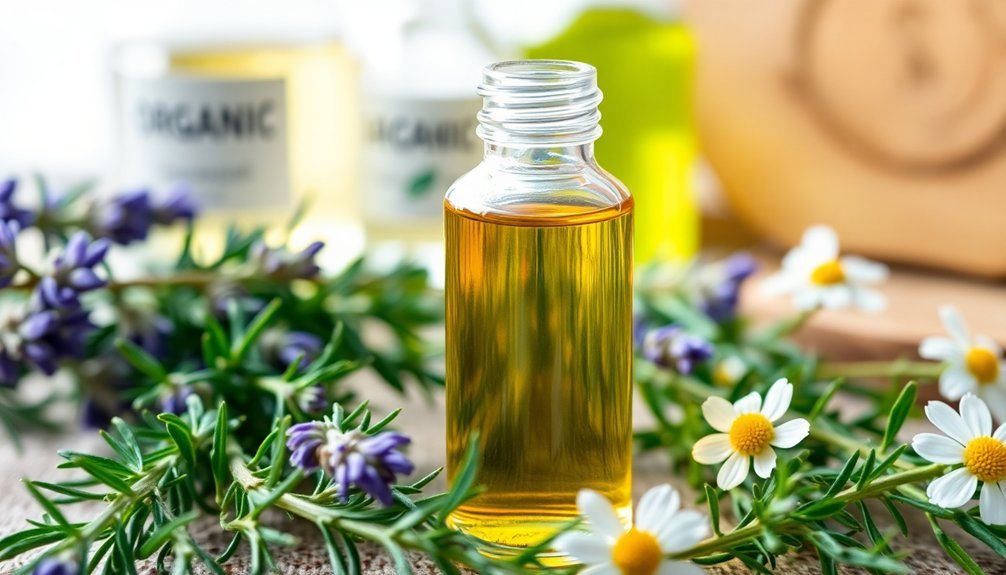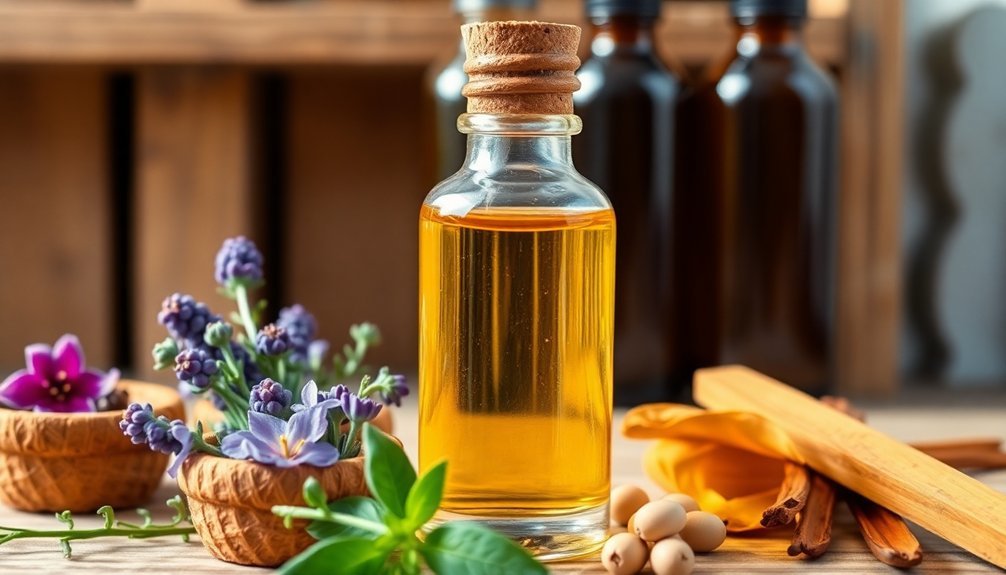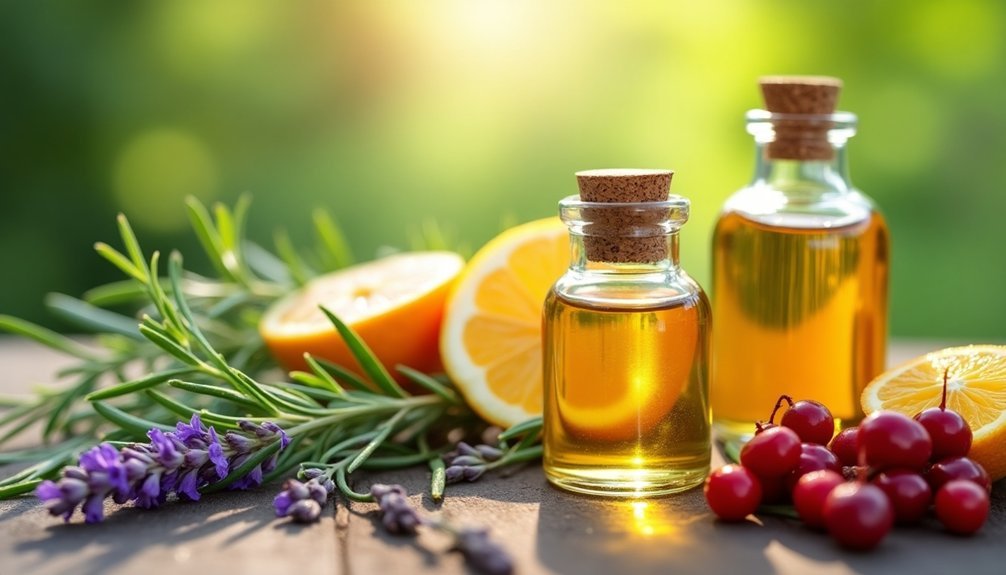The most effective natural preservatives for your homemade perfumes include grapefruit seed extract, sodium benzoate, and potassium sorbate. You'll want to incorporate high-proof alcohol (at least 40%) as your base preservative, while citric acid helps control pH levels. Don't forget antioxidants like Vitamin E and rosemary oleoresin extract to prevent oxidation. Essential oils can act as secondary preservatives, and proper storage techniques enhance preservation. Discover how these ingredients work together to create lasting, safe fragrances.
Understanding Natural Preservatives in Perfumery

While creating natural perfumes can be an art, understanding preservatives is fundamental for maintaining their safety and longevity.
If you're working with water-based fragrances, you'll need preservatives to prevent harmful microorganisms from growing in your product. Without proper preservation, your perfumes can become breeding grounds for bacteria, mold, and yeast.
You'll want to focus on safety and shelf life when selecting preservatives for your formulations. Natural options like sodium benzoate, potassium sorbate, and citric acid can effectively protect your creations while maintaining their natural integrity.
It's essential to understand that preservatives aren't just optional additives – they're critical components that protect both your product and your customers' health. The aging process typically takes 2 weeks to months for the chemical constituents to properly harmonize and stabilize.
Grapefruit Seed Extract: Nature's Antimicrobial Guardian
When using grapefruit seed extract in your homemade perfumes, you'll need to maintain a concentration of no more than 0.1% to prevent skin irritation while still benefiting from its powerful antimicrobial properties.
You can extend your perfume's shelf life considerably with this natural preservative, as it effectively fights against hundreds of bacterial and fungal strains that could contaminate your creation.
While the extract's effectiveness depends on proper sourcing and extraction methods, you'll get the best results by combining it with a full-spectrum preservative in water-based formulations. It's important to note that freshly squeezed GSE won't provide the preservative benefits you're seeking, as it requires industrial processing to be effective.
Effective Usage and Dosage
Although grapefruit seed extract (GSE) offers powerful antimicrobial protection, you'll need to follow specific dosage guidelines to use it safely in your homemade perfumes. For ideal results, maintain concentrations between 0.1% and 1.0% in your final formulation. The extract can remain stable and effective for 24 months or longer when stored properly.
| Usage Factor | Recommendation |
|---|---|
| Ideal Dilution | 1:512 ratio |
| Safe Range | 0.1% – 1.0% |
| Solubility | Water, alcohol, organics |
| Compatibility | Avoid anionic ingredients |
Remember that GSE isn't a complete preservative solution on its own. You'll want to combine it with other natural preservatives for thorough protection. When creating your perfume, start with small test batches to verify compatibility with your chosen ingredients. While GSE works well in various formulations, you'll need to confirm its effectiveness through proper testing before finalizing your recipe.
Shelf Life Benefits
Three remarkable qualities make Grapefruit Seed Extract (GSE) a powerhouse preservative for your homemade perfumes.
First, it's highly effective against over 800 bacterial and viral strains, along with 100 fungal varieties, helping protect your fragrances from microbial contamination. You'll find it works 10 to 100 times better than other antimicrobial ingredients.
Second, GSE starts working within just 15 minutes of contact with harmful organisms, even at dilute concentrations. This rapid action helps maintain your perfume's integrity from the moment you add it.
Finally, when you're using alcohol-based perfume formulations, you'll get enhanced preservation benefits since GSE works synergistically with alcohol.
Just remember to keep the concentration at 0.1% or less to avoid any potential irritation, and you'll enjoy notably extended shelf life for your handcrafted scents.
Extraction Method Concerns
Understanding GSE's extraction methods can make the difference between a safe, effective preservative and a questionable one.
While traditional solvent extraction remains common, it can leave unwanted residues in your final product. Supercritical fluid extraction offers superior purity but comes with higher costs that often get passed down to you.
When selecting GSE for your perfumes, watch for these extraction-related concerns:
- Solvent residues from traditional extraction methods that could irritate sensitive skin
- Variable potency levels due to different extraction techniques affecting bioactive compound concentrations
- Potentially harmful synthetic preservatives sometimes added during less rigorous extraction processes
You'll want to source GSE from manufacturers who use validated extraction methods and provide thorough documentation about their processes.
Consider ultrasonic-assisted extraction as a middle-ground option, offering good purity with reasonable costs.
The Power of Alcohol-Based Preservation Methods

When creating homemade perfumes, alcohol serves as both a powerhouse solvent and a partial preservative. You'll need to verify your formula contains at least 20-30% alcohol content, though 40% is better for antimicrobial protection. While alcohol helps fight off some microorganisms, it shouldn't be your only preservative.
For the best results, use high-proof alcohol (near 100%) to dissolve your essential oils effectively. You'll find that alcohol not only blends your aromatic compounds but also influences how long your fragrance lasts. The higher the alcohol concentration, the longer your scent will stay on your skin.
Remember to age your perfume in a cool, dark place, allowing the oils to fully integrate with the alcohol. Before using, filter your creation through a coffee filter to remove any sediment.
Essential Oils as Secondary Preservative Agents
Beyond their aromatic qualities, essential oils serve as powerful natural preservatives in homemade perfumes. Certain oils, like oregano and thyme, contain phenolic compounds that fight harmful bacteria and fungi, helping to extend your perfume's shelf life naturally.
When combined with rosemary oil, these antimicrobial properties become even more effective.
For ideal preservation in your perfumes, consider these potent essential oil combinations:
- Blend citrus oils with thyme for a fresh, long-lasting fragrance that fights *Staphylococcus aureus*.
- Mix oregano (up to 1%) with rosemary to create a synergistic preservative effect.
- Combine any essential oil with carrier oils like jojoba or sweet almond to prevent skin irritation while maintaining preservative properties.
Remember to dilute these oils properly, as their concentrated forms can be too potent for direct skin contact.
Sodium Benzoate: A Plant-Derived Preservative Solution

You'll find sodium benzoate to be a water-soluble preservative that works best at pH 3, making it ideal for water-based perfumes when used at 0.1-1% of your formula.
While it's synthetically derived from benzoic acid and sodium hydrate, you must avoid combining it with vitamin C or citric acid to prevent potentially harmful benzene formation.
For best results, you should add it to the water phase of your perfume formula and store the finished product in tightly sealed containers to maintain its preservative properties over a two-year shelf life.
Safety And Usage Guidelines
Although sodium benzoate is FDA-approved and considered safe for personal care products, you'll need to follow specific guidelines to use it effectively in your homemade perfumes.
For water-based formulations, maintain a pH of 4.5 or lower, and add the preservative during the water phase at 0.1-1% concentration.
For ideal protection of your perfume, you should:
- Combine sodium benzoate with other preservatives like potassium sorbate to achieve broad-spectrum protection
- Store your ingredients in tightly sealed containers to maintain a four-year shelf life
- Monitor your formula's pH regularly, as the preservative becomes inactive in alkaline conditions
Remember that if you're creating an oil-based perfume without water content, you won't need sodium benzoate since these formulations don't require preservatives to prevent bacterial growth.
Chemical Properties Explained
Understanding sodium benzoate's chemical properties helps explain why this plant-derived preservative works effectively in specific pH ranges. You'll find it's most active at pH 3, though its effectiveness decreases as pH rises above 6. When dissolved in water, it converts to benzoic acid, which is the active form that provides antimicrobial protection.
| Property | Value | Impact on Perfumes |
|---|---|---|
| Appearance | White crystalline powder | Clean, non-staining |
| Solubility | Water-soluble at 1M | Easy incorporation |
| pH Range | 7.0-8.5 in solution | Needs acidic adjustment |
| Stability | Stable but hygroscopic | Store properly sealed |
| Synergy | Works with potassium sorbate | Enhanced preservation |
When using sodium benzoate in your perfumes, you'll need to take into account its solubility in different solvents. It dissolves well in ethanol, glycerol, and methanol, making it versatile for various perfume formulations.
Natural Extraction Process
While many preservatives are synthesized in labs, sodium benzoate's natural extraction process begins with benzoic acid found abundantly in cinnamon bark, apricots, and apples.
You'll find this organic acid can be extracted directly from these natural sources, making it an excellent choice for your homemade perfumes.
The extraction process follows three key steps:
- Harvesting benzoic acid from natural plant sources
- Combining the extracted acid with sodium hydroxide
- Processing the mixture to create stable sodium benzoate crystals
You can source sodium hydroxide naturally too, as it's extracted from brine wells.
When you're working with sodium benzoate, remember it's most effective in water-based formulas with a pH of 4.5 or lower, making it ideal for preserving your natural perfume creations.
Citric Acid: Dual Benefits for Fragrance Preservation
Because citric acid offers both antimicrobial protection and pH control, it's become a valuable natural preservative in homemade perfumes.
When you add citric acid to your fragrance formulations, you'll create an environment that's hostile to bacteria, yeast, and fungi, helping extend your perfume's shelf life naturally.
You'll find that citric acid works as a chelating agent, binding to metal ions that could otherwise compromise your perfume's integrity.
This dual action not only preserves your scent but also helps maintain the stability of other ingredients in your formula.
As an added benefit, you're choosing an environmentally friendly option that's naturally found in citrus fruits.
When you're crafting natural perfumes, citric acid provides a safe, effective way to protect your creations without relying on synthetic preservatives.
Potassium Sorbate in Natural Perfume Making

As you explore natural alternatives to synthetic preservatives, potassium sorbate stands out as a versatile option for homemade perfumes. This white crystalline powder, naturally found in mountain ash berries, offers excellent microbial protection while being gentle and non-toxic.
You'll appreciate potassium sorbate's key advantages in perfume making:
- It dissolves easily in water-based formulations, making it simple to incorporate into your recipes.
- It maintains stability across various pH levels, protecting your fragrances effectively.
- It works synergistically with other natural preservatives to provide thorough protection.
If you're looking to replace parabens in your perfume formulations, potassium sorbate's proven safety record and eco-friendly profile make it an excellent choice.
Remember to follow recommended usage levels for peak preservation of your creative scent blends.
Antioxidants for Extended Perfume Shelf Life
When creating homemade perfumes, natural antioxidants play an essential role in extending their shelf life and maintaining their fragrance integrity.
You'll find powerful options like Vitamin E, Rosemary Oleoresin Extract (ROE), and green tea extract that effectively prevent oxidation and protect your perfume's quality.
To maximize their effectiveness, store your antioxidants in cool, dark places with minimal head space in the containers.
You can combine multiple antioxidants for enhanced protection – try pairing ROE with Vitamin E or using essential oils like neroli that contain natural antioxidant compounds.
Remember to refrigerate your antioxidants when not in use, and always perform a smell test before adding them to your perfume formulations.
For best results, purchase small quantities that you'll use within 6-12 months.
Proper Storage Techniques for Natural Perfumes

While natural perfumes offer beautiful fragrances, their delicate compositions require proper storage to maintain their integrity.
You'll want to store your precious scents in a cool, dark place away from direct sunlight and heat sources. Keep them in their original packaging whenever possible, as it provides an extra layer of protection against environmental factors.
For ideal preservation of your natural perfumes:
- Place bottles in a dedicated drawer or closet shelf where temperatures remain stable.
- Always secure the cap tightly after each use to prevent oxygen exposure.
- Avoid storing in your bathroom, where humidity and temperature fluctuations can degrade the fragrance.
Combining Natural Preservatives for Maximum Efficacy
Beyond proper storage, creating a robust preservation system requires strategic combinations of natural preservatives.
You'll find effective results by combining Gluconolactone and Sodium Benzoate with Lactobacillus Ferment and Coconut Fruit Extract for broad-spectrum protection.
To enhance your preservative system's performance, add Propanediol (Zemea), which allows you to use lower concentrations while maintaining efficacy.
For water-based perfumes, you'll need extra protection.
Consider using Benzyl Alcohol with Dehydroacetic Acid, an EcoCert-approved combination.
Don't rely solely on simple solutions like citric acid or witch hazel, as they won't provide sufficient protection.
Instead, boost your preservation system by incorporating a chelating agent like Phytic Acid alongside your chosen preservative combination.
Remember to test your preservation system's efficacy before finalizing your formula.
Frequently Asked Questions
Can Natural Preservatives Affect the Scent Profile of My Perfume?
Yes, natural preservatives can impact your perfume's scent profile. You'll notice essential oils and alcohol add their own fragrances, while high concentrations needed for preservation can alter your intended scent considerably.
How Long Should I Wait Before Using a Newly Preserved Perfume?
You'll need to wait at least one month before using your newly mixed perfume. This essential melding period lets the scents integrate properly and allows you to test for any adverse reactions.
Are Natural Preservatives Safe for Sensitive Skin Types?
While natural preservatives can be gentler, you'll still need to be cautious. Even natural ingredients like essential oils and citric acid can irritate sensitive skin. It's best to patch test first.
What Signs Indicate My Natural Preservative System Is Failing?
You'll notice your preservative system failing if there's visible color change, fragrance alteration, separation of ingredients, or pH shifts. These signs often appear together and indicate your product isn't properly protected anymore.
Can I Mix Different Brands of Natural Preservatives Together?
While you can mix different brands of natural preservatives, it's not recommended. You'll risk inconsistent effectiveness and potential interactions. Instead, stick to one brand's complete preservation system for reliable results.
In Summary
Now you're equipped with the knowledge to preserve your homemade perfumes naturally and safely. Remember that combining different preservation methods often yields the best results. Whether you're using grapefruit seed extract, essential oils, or alcohol-based solutions, always test your preservative system before finalizing your formula. With proper storage and these natural preservatives, you'll enjoy your unique fragrances for months to come.





Leave a Reply